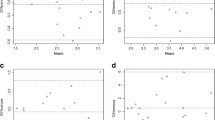Abstract
The aim of this study was to determine the interobserver agreement of two grading systems for pelvic organ prolapse: the vaginal profile and the International Continence Society (ICS) draft proposal. Forty-nine consecutive women referred for evaluation of urinary incontinence and/or pelvic organ prolapse were studied. Patients were first examined by a physician and a nurse clinician using the vaginal profile, followed by an examination according to the technique described in the ICS draft proposal for standardization of terminology (1994). κ statistic and Pearson's correlation coefficient were used to determine interobserver variability for the ICS system by overall stage, by stage-specific comparison, and by specific anatomic location. The vaginal profile was evaluated by obtaining a κ for overall degree of prolapse, stage-specific comparison and by anatomic area. The κ for the ICS stage was 0.79 (P<0.001), and the κ for the vaginal profile by area of greatest prolapse was 0.68 (P<0.001), indicating substantial interobserver agreement for both systems. The ICS system was noted to have substantial interobserver agreement by a stage-specific comparison. All anatomic locations of the ICS staging system were found to correlate significantly, and a high degree of interobserver precision was found. The vaginal profile also showed significant interobserver agreement by overall degree of prolapse, by specific degree of prolapse, and by anatomic area. It was concluded that both the proposed ICS staging system and the traditional vaginal profile show significant interobserver agreement both by overall stage, stage-specific analysis and specific location. The registered nurse examination correlated well with the physican examination, indicating that the most important factor in obtaining reproducible results may be definition and close attention to examination technique.
Similar content being viewed by others
References
Kelly HA, Operative gynecology, Vol 1. New York: D. Appleton & Co, 1898: Chapter XV:449
Baden WF, Walker TR. Genesis of the vaginal profile: a correlated classification of vaginal relaxation.Clin Obstet Gynecol 1972;15:1048–1054
Beecham CT. Classification of vaginal relaxation.Am J Obstet Gynecol 1980;136:957–958
Porges RF. A practical system of diagnosis and classification of pelvic relaxation.Surg Gynecol Obstet 1963;117:769–773
Friedman EA, Little WA. The conflict in nomenclature for decensus uterii.Am J Obstet Gynecol 1961;81:817–820
International Continence Society Committee on Standardization of Terminology. The standardization of terminology of female pelvic organ prolapse and pelvic floor dysfunction. Final Draft Proposal. ICS: 1994
Porges RF, Porges JC, Blinick G. Mechanisms of uterine support and the pathogenesis of uterine prolapse.Obstet Gynecol 1960;15:711–726
DeLancey JOL. Pelvic floor research: where are we now and where can we go?J Pelv Surg 1995;4:185–188
Shull BL. Clinical evaluation of women with pelvic support defects.Clin Obstet Gynecol 1993;36:939–951
Kramer MS, Feinstein AR. Clinical biostatistics LIV. The biostatistics of concordance.Clin pharmacol Ther 1981;29:111–123
Byrt T, Bishop J, Carlin JB. Bias, prevalence and kappa.J Clin Epidemiol 1993;46:423–429
Delancey JOL. Anatomy and biomechanics of genital prolapse.Clin Obstet Gynecol 1993;36:897–909
Porges RF, Smilen SW. Long-term analysis of the surgical management of pelvic support defects.Am J Obstet Gynecol 1994;171:1518–1528
Brubaker L. Sacrocolpopexy and the anterior compartment: support and function.Am J Obstet Gynecol 1995;173:1690–1696
Author information
Authors and Affiliations
Additional information
EDITORIAL COMMENT: There has recently been a great deal of interest in the anatomy and physiology of the pelvic floor and the various investigative techniques to define its function. The lack of a standardized and reproducible system to describe pelvic organ prolapse through the hiatus of the pelvic floor has hampered research into its pathophysiology and treatment. The authors applied a validated κ statistic and Pearson's correlation coefficient to convincingly measure interobserver reliability for the ICS system and indicated an index of trend between points on the ICS scale as well.
Rights and permissions
About this article
Cite this article
Kobak, W.H., Rosenberger, K. & Walters, M.D. Interobserver variation in the assessment of pelvic organ prolapse. Int Urogynecol J 7, 121–124 (1996). https://doi.org/10.1007/BF01894199
Issue Date:
DOI: https://doi.org/10.1007/BF01894199




